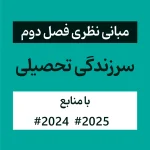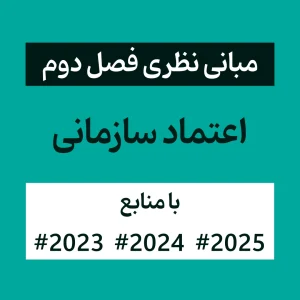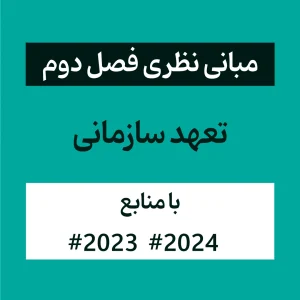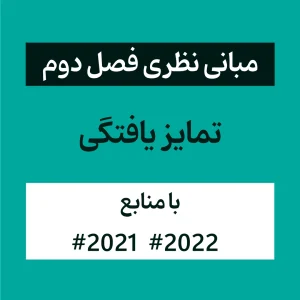نقد و بررسی
مبانی نظری و پیشینه پژوهش سرزندگی تحصیلی با منابع 2024-2025فهرست مطالب:
- سرزندگی تحصیلی
- عوامل اثر گذار بر سرزندگی تحصیلی
- سرزندگی تحصیلی و چالش ها
- پیش بینی کننده های سرزندگی تحصیلی
- نظریه های سرزندگی تحصیلی
- منابع غیر فارسی
بخشی از محصول
انسان ها در دوان زندگی خود، مسیر پر فراز و نشیبی را طی می کنند که سرشار از چالش ها و فرصت های است و در مواجهه با چالش ها از توانمندی هایش استفاده می کنند تا با موقعیت های مختلف و چالش ها و تهدیدهای ناشی از آن سازگار شود. بخش مهمی از چالش های زندگی هر انسان مربوط به چالش های تحصیلی در دوران تحصیل ( مانند نمرات ضعیف، کاهش انگیزش، استرس، تهدید اعتماد به نفس) می باشد. به همین دلیل سازگاری و انطباق دانش آموزان با این چالش ها در افزایش عملکرد تحصیلی آنها دارای اهمیت ویژه ای است (بردت و همکاران، 2018).
یکی از جنبه های سازگاری دانش آموزان با فشارهای تحصیلی که مورد توجه روان شناسان تربیتی است، سرزندگی تحصیلی می باشد (چن ، 2019). سرزندگی تحصیلی به پاسخگویی مثبت و انطباق با انواع موانع و چالش ها در عرصه تحصیل تجربه می شود اشاره می کند. دانش آموزان بیشتر اوقات خود را در مدرسه طی می کنند، باید عوامل تأثیر گذار بر ظرفیت دانش آموزان در مواجهه با چالش های تحصیلی که باعث سر زندگی تحصیلی آنها می شود شناسایی شوند. پیشایندهای سر زندگی تحصیلی در سه سطح روانی، عوامل مربوط به مدرسه و مشارکت در فرآیند تحصیل و عوامل مربوط به خانواده و همسالان مورد بررسی قرار گرفته است (آمابیل ، 1994).
Non-Persian References
- Torkani, F., Ahmadi, SH., Binazir, A(2025). The relationship between health-related quality of life and academic success in nursing students: the mediating role of academic burnout and academic motivation. BMC Med Educ 25, 42 . https://doi.org/10.1186/s12909-025-06661-6
- Cayubit, R.F.O(2024). The impact of COVID-19 anxiety on the academic motivation, life-orientation, and meaning in life of university students. Discov Psychol 4, 176 . https://doi.org/10.1007/s44202-024-00298-0
- Griesbach S, Theobald M, Kolman K, et al.. Joint guidelines for protected nonclinical time for faculty in family medicine residency programs. Fam Med. 2021;53(6):443–452. 10.22454/FamMed.2021.506206
- Livingston-Rosanoff D, Park KY, Alagoz E, Thibeault S, Gibson A. Setting up for success: Strategies to foster surgeons’ pursuit of basic science research. J Surg Res. 2021;268:71–78. 10.1016/j.jss.2021.06.035
- Rotenstein LS, Holmgren AJ, Downing NL, Bates DW. Differences in total and after-hours electronic health record time across ambulatory specialties. JAMA Intern Med. 2021;181(6):863–865. 10.1001/jamainternmed.2021.0256.
- Rao S, Ferris TG, Hidrue MK, et al.. Physician burnout, engagement and career satisfaction in a large academic medical practice. Clin Med Res. 2020;18(1):3–10. 10.3121/cmr.2019.1516.
- Williams AM, Reed B, Self MM, Robiner WN, Ward WL. Psychologists’ practices, stressors, and wellness in academic health centers. J Clin Psychol Med Settings. 2020;27(4):818–829. 10.1007/s10880-019-09678-4.
- Gafni, R., & Gersteinl, R. D. (2020). Examining the relationships among faculty self‐efficacy, engagement, and support for teaching with technology. Journal of College Teaching & Learning (TLC), 17(1), 75-91
- Altbach, P.G., & Engberg, M.E. (2019). Leadership in American higher education: Current trends and challenges. International Journal of Educational Development, 67, 69-75.
- Chen, Q. (2019). The impact of organizational justice on employees’ loyalty in higher education institutions. Review of Economics & Finance, 18(1), 149-165.
- Lammers, E. S., Koerner, M. M., & Toman, N. E. (2019). Faculty job satisfaction: A systematic review. Journal of Career Development, 46(5), 472-491.
- Mekhelear, M. (2019). Leaders’ characteristics and job satisfaction in higher education institutions. Journal of Educational Research, 112(3), 326-337.
- Brodt, S. E., Daire, A. P., Mack, M. G., & Fraser, H. N. (2018). Transformational leadership, instructional leadership, faculty trust in colleagues, and collective efficacy at Hispanic-serving community colleges. Community College Journal of Research and Practice, 42(6), 449-464.
- Brown, K. (2018). The impact of instructional leadership on faculty engagement and loyalty in a specific discipline within a MAED program. Journal of Higher Education Management, 33(2), 87-101.
- Cox, M. D., Weaver, G. C., Trevino, L. K., & Wetzel, C. D. (2018). Mentoring faculty in higher education. The Journal of Applied Behavioral Science, 54(1), 5-26.
- DePaola, T., & Folger, W. (2018). Work-Life Balance: perceptions, policy, and practice in higher education. New Directions for Higher Education, (181, 125-135.
- Hirschman, A. O., Jenssen, A. G., & Totterdill, P. (2018). The causes and consequences of faculty workload on the quality of work in the knowledge economy. The Learning Organization, 25(3), 155-168.
- Segerholm, C., & Byrskog, U. (2018). Building faculty loyalty: Balancing demands for efficiency with real communities of practice. Journal of Higher Education Policy and Management, 40(1), 82-97.
- Varpio L, Ray R, Dong T, Hutchinson J, Durning SJ. Expanding the conversation on burnout through conceptions of role strain and role conflict. J Grad Med Educ. 2018;10(6):620–623. 10.4300/JGME-D-18-00117.1
- Walling A. Academic Promotion for Clinicians. A Practical Guide to Academic Promotion and Tenure in Medical Schools. Cham, Switzerland: Springer International Publishing; 2018.
- Lewiss RE, Silver JK, Bernstein CA, Mills AM, Overholser B, Spector ND. Is academic medicine making mid-career women physicians invisible? J Womens Health (Larchmt). 2020;29(2):187–192. 10.1089/jwh.2019.7732.
- Nassar AK, Waheed A, Tuma F. Academic clinicians’ workload challenges and burnout analysis. Cureus. 2019;11(11):e6108. 10.7759/cureus.6108.
- Amabile, T. M., Hill, K. G., Hennessey, B. A., & Tighe, E. M. (1994). The work preference inventory: assessing intrinsic and extrinsic motivational orientations. Journal of Personality and Social Psychology, 66(5), 950-967.








0دیدگاه